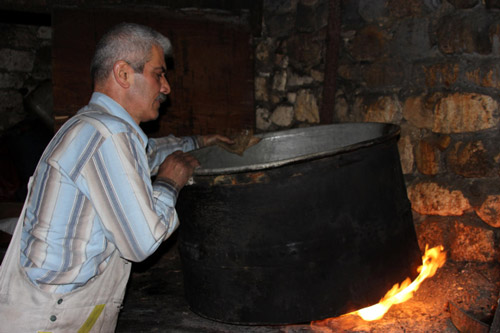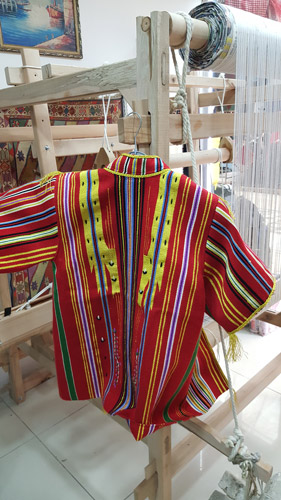COPPERSMITH

Since the age of Copper, where mankind started to process copper ore, it is the profession that has survived to the present day. All civilizations have left traces of copper in Hatay since the copper age. Hatay coppersmith holds a distinctive place with its unique motif, craftsmanship and labour. A separate Arasta Street, known as the coppersmith’s bazaar, is still located in the long bazaar in Antakya.
Copper pots, which add a distinct flavour to the dishes, replaced with aluminium steel nowadays, but it cannot compensate the copper. Aşur (Hirise), which has an important place in Hatay Gastronomy, cannot get the consistency without being beaten in sizable copper pot. Once upon a time, the copper pots were sold with the seal of the masters and the names were engraved on their backs in order to not to be confused by the owners.
Nowadays, there are still craftsmen who continue this profession in coppersmith’s bazaar in Hatay. They do not only produce special pots and pans for the region, but also sell souvenirs. For example, they sell special pots and pans for Öcce (hash browns), Sarma (stuffed vine leaves), Dolma (farci), Künefe, and other items such as pitcher and tray and this attracts new generations. In addition, a museum of copper goods was opened to visit in the traditional Antakya house, which was recently renovated by the Hatay Chamber of Commerce.



TINSMITH

Tinsmith is also a very old profession. It is salt ammoniac tinning the old, worn out and abraded pots and pans.
Tinsmith is considerably reduced with the use of steel, teflon, enamel and aluminium products. Thanks to those who still use copper pots and trays and appreciate these items, this profession is carried out by some masters.
Copper mines in Hatay have been processed since ancient times. Tinsmith has also been maintained. Today, there are few masters in the districts who continue this profession. Tin is an expensive metal and tinsmith is difficult. There are three basic rules. Tempering, cleaning and tinning the pots and pans. Tin is the antidote to copper’s poison.
Giving hygiene to copper is to add flavour to the dishes made in it.
PACKSADDLE

Packsaddle is a device that designed to be secured on the back of a horse, donkey and mule so it can carry heavy loads. ‘Semerci’ is called to the master of this device who makes and sells them. In order not to damage the animal’s back, packsaddles made on the tree skeleton and felt by wrapping grass weed. It is a very painstaking craft.
An unbalanced packsaddle causes injury to the back of the animal.
The name of the packsaddle varies from region to region (for example: Peki, Palan, Kürtün). The main part of the packsaddle, which is located between the back of the animal and the wooden skeleton, is called mould.
The wooden part surrounding the mould is called ‘skeleton’. The skeleton consists of two main parts, the front and rear bezels.
On the front and rear bezels, there are chipped tree pieces called “finger”, and again, the board that connect the front and rear bezels are called “side boards” or “ribs”. There are six of them, three on the right and three on the left.
RUG – ABA MAKING

Rug and Aba making, which goes back to very ancient nomadic cultures, has been going on for centuries with traditional methods in our city. And today it can be maintained with the efforts of very few masters. Aba clothes worn in Yayladağı Aba Wrestling, carries unique colours and motifs.
Each colour, pattern and figure contains different meanings. Yarns could be obtained with root dyes until recently, but these dyes have been replaced by yarns prepared with industrial fabric dyes.
The last generation of Antakya Rug and Aba masters, who work with traditional methods, endeavour to maintain their profession with great difficulties and costs.
Some say that one of the last representatives of the profession, Traditional Antakya Rug and Aba Master Abdullah Akar, protects his antique loom like an eye.
This Master has a place on the Guinness World Records with the special 75-meter rug he weaved in 75 days for the 75th anniversary of Hatay’s becoming a Turkish city.
In addition to this, traditional Hatay Aba was exported to 72 countries.



